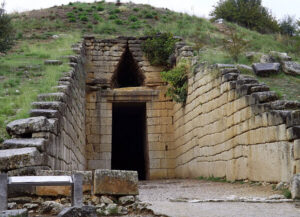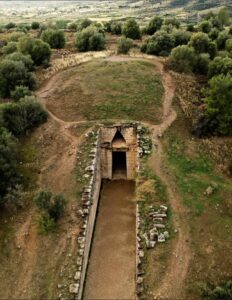The Treasury of Atreus, also known as the Tomb of Agamemnon, is one of the most iconic architectural feats of the Mycenaean civilization. Situated near Mycenae, Greece, this tomb dates back to around 1250 BC and remains an awe-inspiring testament to the engineering brilliance of the ancient Greeks. Despite its common name, its exact purpose and the identity of its occupant continue to be shrouded in mystery, adding an air of intrigue to its already impressive stature.
A Monumental Entrance: The Lintel Stone
The first striking feature of the Treasury of Atreus is its massive entrance, which stands as a symbol of Mycenaean engineering prowess. Dominating the entrance is a 120-ton lintel stone, one of the largest ever used in the ancient world. This colossal stone forms the threshold of the tomb, and its sheer size poses an enduring question: how did the Mycenaeans manage to transport and position such an enormous block of stone without the use of modern machinery or tools?
Archaeologists and engineers alike have marveled at the ingenuity involved in moving the lintel stone into place. Some theories suggest that the Mycenaeans may have employed a system of ramps and sledges, while others propose the use of manpower and simple levers. Yet, despite years of research, the precise techniques remain a captivating enigma.

The Dome: A Masterpiece of Construction
As you enter the tomb, the true brilliance of Mycenaean architecture becomes evident in the form of the corbelled dome. Rising nearly 45 feet in height and spanning a diameter of 47 feet, this dome was the largest of its kind for over a millennium, a marvel that stood as a symbol of architectural achievement in the ancient world. The use of corbeling, where stones are carefully stacked to support one another, allowed the dome to stand without the need for mortar.
The construction of such a massive structure was an immense challenge, and the Mycenaeans met it with exceptional skill. Each stone was placed at a slight angle, leaning inward to create a self-supporting framework. The precision with which these stones were cut and placed is a testament to the Mycenaeans’ advanced knowledge of geometry and construction techniques, and it illustrates their ability to harness the natural properties of stone to create something enduring.
A Tomb or a Treasury?
While it has become known as the Treasury of Atreus, there is much debate over whether the structure was indeed intended as a tomb. The term “treasury” suggests that it may have been a storage place for valuable items, perhaps for a ruler or priest. Greek mythology links the tomb to figures like Atreus and Agamemnon, legendary kings of the House of Atreus, which has fueled speculation that the tomb was intended for one of these famed leaders. However, despite these associations, there is no definitive archaeological evidence to confirm the identity of the occupant.
The idea that this was the burial place of Agamemnon, the hero of the Trojan War, has been popularized by myth, but again, no conclusive proof exists. What is certain, however, is that the tomb’s grandeur suggests it was meant for someone of great importance—whether that be a high-ranking official, a ruler, or a legendary figure from the myths.

Looted but Enduring: The Tomb’s Legacy
Though the tomb was likely plundered in antiquity, its mythological associations and architectural significance have ensured that it remains a focal point of both historical study and public fascination. The grandeur of the structure and its ties to stories like those of Atreus and Agamemnon continue to captivate people around the world. Over time, the tomb has become a symbol not only of the Mycenaean civilization but of the enduring power of myth and legend in shaping our understanding of the ancient world.
Today, the Treasury of Atreus stands as one of the most remarkable and well-preserved examples of Mycenaean craftsmanship and engineering. It remains a vivid reminder of the achievements of an ancient society that, though long gone, left behind structures that continue to inspire awe and admiration.
An Enduring Enigma
The true purpose of the Treasury of Atreus may never be fully understood, but it stands as a monumental legacy of Mycenaean culture. Its construction demonstrates a high level of sophistication and technical expertise, while its mysterious associations with mythological figures add layers of intrigue and depth. Whether a tomb, a treasury, or something else entirely, the Treasury of Atreus continues to be a source of fascination, offering valuable insights into the past while keeping some of its secrets safely hidden beneath its ancient stones.
